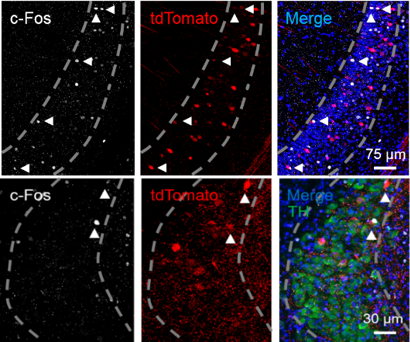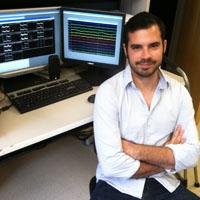Research
Our lab is interested in the neural mechanisms governing working memory and attention-guided behavior. To this end, several overarching questions currently guide our research.
Which circuits are important for attention and working memory? Are these circuits distinct, or overlapping?


The brain is functionally organized into discrete anatomical circuits – groups of neurons that send axons to, and receive synaptic contact from, other groups of neurons. Much research in the past decade has demonstrated that specific circuits have tight relationships with behavior – circuits within the same brain region can even control opposing behavioral phenotypes! It is tempting, therefore, to assume that cognitive functions, like attention and memory, also rely on function in discrete circuits. Where are these circuits located? To tackle this question, we use a combination of viral tracing, touchscreen-guided behavioral testing, and immunohistochemistry in mice. We think that the results from these experiments will lead to a higher resolution “road map” for attention and working memory in the brain, and could also lead to novel ideas about circuit disruption in patients with attentional and memory-related symptoms.
How do these circuits encode behavior during attention and working memory-guided tasks?

How do circuits communicate during behavior? What is the nature of their interaction? Which neurons do the talking, and which neurons listen? How does brain activity reflect attention and working memory in real time? To answer these questions, we record activity from several interconnected regions of the brain simultaneously during touchscreen-guided behavior. Using this technique, called in vivo electrophysiology, allows us to eavesdrop on cellular activity in a behaving animal, and correlate that activity with attentional and memory-related aspects of task performance. We expect that results from these experiments will lead to the identification of novel “signals” from the brain that could predict attention and memory deficits in patients with neuropsychiatric and neurodegenerative disorders.
Do attention and working memory circuits selectively express specific genes? Are these genes causally implicated in attention and working memory-guided behavior?

It has become increasingly clear that neurons are not only anatomically heterogenous (communicating with a diverse array of other neurons), but also genetically heterogenous, expressing unique sets of genes that can be used as molecular “markers” of neuron identity. In humans, we are only beginning to understand how expression of these genes in the brain might be related to cognition, as well as risk for the development of neuropsychiatric disorders that impact cognition. One obstacle to this line of research is that genes are not expressed in the same way all over the brain – on the contrary, different neurons show diverse patterns of gene expression. To overcome this obstacle, it will be necessary to understand which genes are expressed in specific “types” of neurons. Do neurons in attention and memory-associated circuits express special sets of genes? Could these gene expression patterns be used to identify these neurons, even when other anatomical information is not available? To answer these questions, we use a combination of viral tracing and single-molecule in situ hybridization to measure gene expression in individual brain cells. To causally relate expression of these genes with attention and working memory, we use CRISPR/Cas9-mediated targeting in these cells. These results will be critically important for our understanding of the complex relationship between genotype and phenotype in disorders that feature attention and memory-related symptoms.
